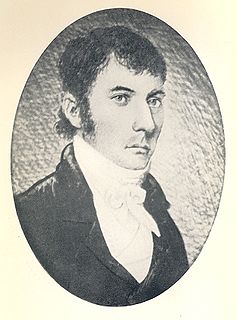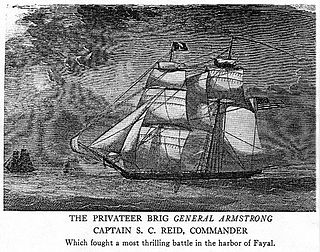At least four Canadian brigs, three of them bearing letters of marque, bore the name Sir John Sherbrooke or Sherbrooke during the War of 1812. All were named after Sir John Coape Sherbrooke, governor of Nova Scotia.

The War of 1812 was a conflict fought between the United States and the United Kingdom, with their respective allies, from June 1812 to February 1815. Historians in Britain often see it as a minor theatre of the Napoleonic Wars; historians in the United States and Canada see it as a war in its own right.

General Sir John Coape Sherbrooke, GCB was a British soldier and colonial administrator. After serving in the British army in Nova Scotia, the Netherlands, India, the Mediterranean, and Spain, he was appointed Lieutenant-Governor of Nova Scotia in 1811. During the War of 1812, his policies and victory in the conquest of present-day Maine, renaming it the colony of New Ireland, led to significant prosperity in Nova Scotia.

Nova Scotia is one of Canada's three Maritime Provinces, and one of the four provinces that form Atlantic Canada. Its provincial capital is Halifax. Nova Scotia is the second-smallest of Canada's ten provinces, with an area of 55,284 square kilometres (21,300 sq mi), including Cape Breton and another 3,800 coastal islands. As of 2016, the population was 923,598. Nova Scotia is Canada's second-most-densely populated province, after Prince Edward Island, with 17.4 inhabitants per square kilometre (45/sq mi).
- Sir John Sherbroke (1804 ship) was built in Nova Scotia. She wrecked in 1816 and her crew made off with 56,000 dollars that she was carrying.
- Sir John Sherbrooke (Halifax) was the most famous privateer by this name. A brig of 278 tons burthen, she was commissioned in 1813. An American privateer captured and burned her in 1814.
- Sir John Sherbrooke (Saint John) was a brig of 187 tons burthen, ten guns and thirty men. She was commissioned 27 November 1812. The American privateer Saucy Jack captured her on 30 October 1813.
- Sherbrooke (Barbados) was a brig of 205 tons, eleven guns, commissioned 27 August 1814 and confiscated in April 1815.
Sir John Sherbrooke was built in 1804 in Nova Scotia. She first appeared in the British registers in 1815 and was wrecked in 1816.
Sir John Sherbrooke was a successful and famous Nova Scotian privateer brig during the War of 1812, the largest privateer from Atlantic Canada during the war. In addition to preying on American merchant ships, she also defended Nova Scotian waters during the war. After her conversion to a merchantman she fell prey to an American privateer in 1814. She was burnt to prevent her reuse.
The Sir John Sherbooke of Saint John, New Brunswick was the American brig New Orleans Packet that HMS Guerriere detained in August 1811. She was condemned at Saint John and local merchants purchased her. They named her after Sir John Coape Sherbrooke, Governor of Nova Scotia. After the outbreak of the War of 1812 she acquired a letter of marque. An American privateer captured her in October 1813.
| This article includes a list of ships with the same or similar names. If an internal link for a specific ship led you here, you may wish to change the link to point directly to the intended ship article, if one exists. |





